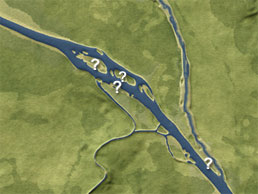- Home
- The city
- The first inhabitants
- The Gallic Lutetia
The only mention of Gallic Lutetia is found in Caesar's Gallic Wars, where Caesar tells us that Lutetia was an oppidum of the Parisii people, and that-like the oppidum of the Senons tribe-it was built on an island in the Seine. Based on this literary source, historians have tended to associate the oppidum of the Parisii with the Île de la Cité, making Paris' largest island the city's birthplace.
An oppidum on the Île de la Cité ?
This theory is supported by several facts. First, the island-as it appeared in Antiquity-is the largest in the Paris area.
Second, in 1711, sections of the Boatmen's Pillar were discovered beneath Notre-Dame cathedral. Even though the pillar was a testament to the Romanisation of Lutetia, it bore representations of divinities from the Gallic pantheon. In addition, the main Roman road that crossed the island from north to south proves that the island was already to both banks by bridges that probably replaced the ones mentioned by Caesar. One final argument is that Caesar compared the island with the Île de Melun, whose present topography is very similar to the Île de la Cité.
An uncertain identification
This identification assumes that the configuration of the islands and the course of the Seine since protohistoric times remained relatively unchanged-a claim that is invalidated by recent excavations along the banks. It now appears that the island was given its current shape by the quays built by the Romans. Prior to this, we must imagine a group of islets surrounding a main island whose surface area did not exceed 9 hectares. Finally, multiple excavations on the island have not revealed any layer dateable to the Gallic period-no fortifications, no burn layers, and no trace of urban development.
Possible locations of the oppidum.
3D graphics © A.-B. Pimpaud.
Despite this lack of connection between historical and archaeological sources, we cannot rule out the possibility that the oppidum was on the Île de la Cité. There are several possible explanations for the lack of vestiges. The term "oppidum" could have been used to designate a fortification that may have been built only a short time before the Conquest. Any remaining traces of this may have been swept away by frequent flooding and by the extensive urban development of the island in the Early Roman Empire.
However, recent research proves that other places in the immediate periphery of the current city of Paris present a topography coinciding with the sources and are excellent candidates for Gallic Lutèce.
Other locations
It is quite possible that the oppidum that was destroyed was located on another island or peninsula that has since disappeared. Several sites in the Paris area correspond to Caesar's description:
- The space between the Seine's former branch on the right bank and its current location would have created a zone protected by marshland. However, this theory is not supported by any archaeological discovery.
- Some discoveries have been made on the Île Saint-Louis, but they are not well documented.
- A series of occupation layers dating from the Neolithic to the Roman era have been uncovered on the left bank at the level of the Sully bridge, but none of the discoveries indicates the nature of the Gallic-era occupation.
"In search of the Lost Opidum"
There is very little proof of a Gallic presence on the site of Paris at the time of the Gallic wars. We have yet to discover remains of the oppidum. We should not be surprised if Roman Lutetia was moved several kilometres from its protohistoric location, as this was common practice for the capitals of Gallic tribes. But such movements are usually accompanied by a name change. The fact that the name Lutetia was retained during the Roman period suggests that the Gallic oppidum is not far away.
